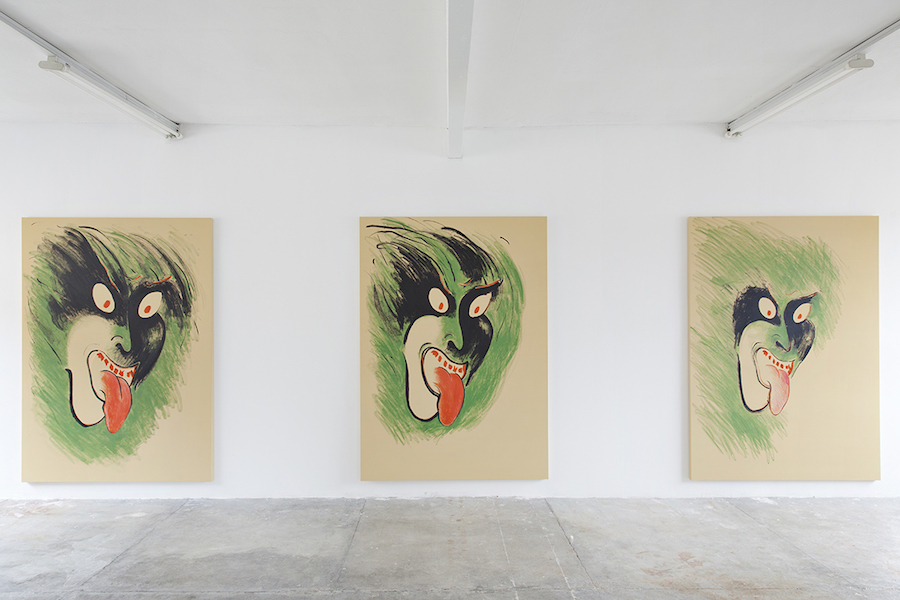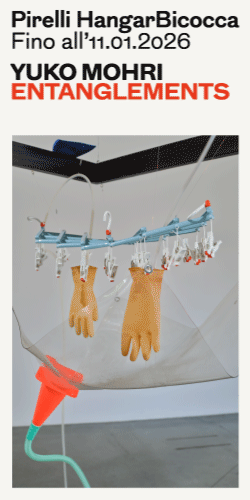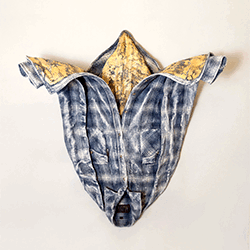[nemus_slider id=”50909″]
English text below
Tecniche intriganti, materiali differenti, logiche espositive precise e richiami culturali tutti da indagare sono alcuni degli ingredienti della prima mostra personale dell’artista americano Calvin Marcus in Italia ospitata fino al 23 gennaio allo spazio Peep-Hole in Via Stilicone, Milano.
Nato nel 1988, Marcus ha, nonostante la giovane età, molto chiaro il percorso del proprio lavoro: un esempio ne è l’esigenza di creare un preciso percorso espositivo “a senso unico”, che si “annulla” procedendo a ritroso. Infatti le opere, 10 autoritratti a olio su tela di grandi dimensioni, composti come schizzi o bozzetti, e realizzati con la tecnica del pastello a cera, invitano il visitatore a compiere un passaggio attraverso di loro, un avvicinamento e, al momento del ritorno verso l’uscita, ci si troveranno davanti soltanto i muri bianchi della galleria; se entrando ci si trova osservati e circondati dai grandi visi “demoniaci” tesi in smorfie, uscendo le immagini si nascondono, lasciando alla mente lo spazio che l’occhio aveva precedentemente conquistato.
I colori dei dipinti – nero, verde acido, rosso aranciato – e le espressioni grottesche e beffarde riportano alla mente non soltanto gli espressionisti tedeschi ma soprattutto, grazie alle linee curve e morbide di quelli che sembrano grandi bozzetti, i grandi poster pubblicitari degli anni tra le due guerre. Un’iconografia interessante, che ovviamente non ha niente a che vedere con la vera fisionomia dell’artista, ma che lo identifica con un immaginario artistico e quotidiano familiare a tutti noi.
Altro nucleo di opere in mostra è un gruppo di piccole sculture in ceramica smaltata, dai colori tenui e le forme incerte, che raffigurano squaletti o altri pesci antropomorfi contenuti in piccole piscine (o posacenere, data la fattura) intenti a rilassarsi, conversare tra loro o dormire, a volte circondati da oggetti quotidiani – anch’essi in ceramica e di piccole dimensioni – apparentemente fuori posto, come un mocio o patatine fritte. Simpatici e ironici, questi piccoli lavori sembrano realizzati senza la preoccupazione di raggiungere la verosimiglianza, la precisione e la perfezione formale; quasi come oggetti creati da bambini, assomigliano a divertissement creati per hobby, ma rappresentano anche il divertimento e la libertà della creazione di mondi onirici popolati di personaggi fantastici, così come la capacità e la voglia dell’artista di approcciare diverse tecniche e materiali e sperimentare quanto più possibile.
In merito alla mostra abbiamo rivolto qualche domanda all’artista —
ATP: I tuoi dipinti sono definiti autoritratti: da dove viene la scelta di questa forma di rappresentazione e di questa iconografia surreale? Quali ne sono le fonti?
Calvin Marcus: Lavoro con una moltitudine di medium e iconografie, I grandi disegni a Peep-Hole e le ceramiche sono due cose che probabilmente hanno moltissime ispirazioni come i dipinti kabuki giapponesi ma la citazione è soltanto accidentale. Ho pensato ai disegni come loghi grafici rappresentativi della ritrattistica, nonostante non siano in riferimento diretto con nulla in particolare. Cerco di inventare più che posso.
ATP: Le tecniche e i materiali che usi sono molto diversi tra loro. Cosa ti interessa della sperimentazione?
CM: Non sono interessato a creare un “brand” con le mie opere… Non aspiro a padroneggiare molte tecniche e poi liberarmene. Sperimento nella misura in cui ne ho bisogno per capire come fare le cose che mi interessa fare. Detto questo, sperimento tanto, da un estremo all’altro, per far sì che alcune cose appaiano e vengano sentite come serve che siano.
ATP: La mostra da Peep-Hole ha un suo preciso percorso e l’allestimento attuale, da te fortemente voluto, è molto importante. In questo modo, potremmo dire, hai creato una tua presenza, una sorta di tuo “autoritratto” anche in questo. Perché?
CM: Nelle mostre che ho fatto finora (due) ho voluto fare sì che l’idea dell’artista/artigiano fosse presente. Voglio che l’esperienza stessa rifletta la mia presenza. Le opere in sé stesse sono un modo per sottolineare un aspetto, una caratteristica, un personaggio, un artista o chiunque altro.
ATP: Vuoi invece raccontarci come nascono le piccole sculture di ceramica e cosa rappresentano?
CM: Le ceramiche rappresentano creature antropomorfe che si rilassano all’interno di oggetti dalla forma di piatto o conchiglia. Sono creature che si comportano come gli umani; in uno stato di relax e divertimento.
ATP: Come mai hai scelto di portare proprio queste opere per la tua prima personale italiana?
CM: Quando ho incontrato Bruna e Vincenzo a Milano qualche mese prima della mostra ho prestato particolare attenzione all’architettura dello spazio e alla sua forte simmetria. Quando sono ritornato al lavoro a Los Angeles stavo lavorando all’ingrandimento di disegni che rappresentano dei visi rivolti verso destra e verso sinistra; quest’opera era già in corso di lavorazione molto prima del momento in cui mi sono concentrato sull’allestimento per Peep-Hole, ma mi è sembrato il luogo perfetto per delle opere che avessero una direzione precisa. Le ceramiche sono un’importante componente di opposizione nella mostra, le loro facce rassicuranti e il loro comportamento rilassato si scontrano infatti con l’intensità e l’aspetto di sfida che invece i dipinti stregati della navata hanno.
ATP: I tuoi prossimi progetti?
CM: Ho in cantiere due personali con il mio amico Chadwick Rantanen alla Clearing gallery a Brussels, e una mostra alla David Kordansky gallery a Los Angeles, tutte in gennaio.

Interview with Calvin Marcus – Peep-Hole, Milan
Intriguing techniques, different materials, precise display logic and to-discover cultural references are some of the ingredients of the exhibition Calvin Marcus at Peep-Hole, first solo exhibition of the American artist Calvin Marcus in Italy, which opened on November 19th in the exhibition space of Via Stilicone.
Born in 1988, Marcus has, despite the young age, a really precise idea of the route of his work: an example is the need to create a clear “one way” path through the exhibition, that “cancel itself” when going backwards. In effect the works, ten big oil on canvas self portraits, created as sketches, and realized with the wax pastels technique, invite the visitor to pass trough them, to an approach, and, when walking back to the exit, what is to be seen are just the rough and white walls of the gallery; if entering it’s easy to feel yourself observed and encircled by the gigantic “evil” faces stretched in different grimaces, exiting the images will catch themselves, leaving to the mind the space that the eye had conquered before.
The colors of the paintings – black, sour green, orange red – and the grotesque and mocking expressions do not only recall German expressionists but most of all, thanks to the soft and curvy lines of what look like very big sketches, the big advertisement posters of the 30s and 40s. An interesting iconography, which has very clearly nothing to do with the real physiognomy of the artist, but that identifies himself with a familiar daily-life and artistic consciousness.
Another unit of works exhibited at Peep-Hole is a group of little glazed ceramics sculptures, characterized by light colors and uncertain forms, that represent small sharks or other anthropomorphic fish contained in some little pools (or ashtray, as the shape remember) intent in relaxing, having conversations or sleeping, sometimes accompanied by daily-life objects – always made out of ceramics and of very reduced dimensions – apparently incongruous like a mop or french fries. Funny and ironic, these little works look like having been realized without the stress of the achievement of likeness, preciseness of formal perfection; almost like things done by kids, they seem to be simple divertissement used as pastime, but represents also the fun and freedom of the creation of dream-worlds, filed with fantastic characters, as also the ability and desire of the artist to approach different techniques and materials and experiment as much as possible.
Thinking about the exhibition, we addressed some question to the artist, curios about his work:
ATP: Your paintings are defined as self portrait: where does the choice of this form of representation and this surreal iconography come? Which are the sources of that?
CM: I work throughout a multitude of mediums and iconographies, the large drawings at Peep-Hole and ceramics are two things that probably have plenty of references such as the Japanese kabuki paintings but that was just coincidental. I thought about the drawings as illustrative graphic logos of portraiture though weren’t in direct reference to anything in particular. I try to invent as much as I can.
ATP: You use very different techniques and materials. What is your interest in experimentation?
CM: I am not interested in creating a “brand” with my stuff… I do not aspire to master techniques and flush them out. I experiment as needed to understand how to make the things I am interested in making. Having said that, I do go to extreme lengths to make certain things feel and look the way they need to be.
ATP: The exhibition at Peep-Hole has a precise and privileged route and the present display, which you strongly wanted, is very important. In this way, I’d say, you recreated your presence, a kind of “self portrait” also under this point of view. Why?
CM: Within the exhibitions I have done so far (2) I have wanted the idea of the artist / maker to be present. I want the experience itself to be reflective of my presence. The work itself is a certain kind of heightening of a character or artist or whomever.
ATP: Would you like to tell us how were the little ceramic sculptures born and what do they represent?
CM: The ceramics present anthropomorphic creatures relaxing in dish/shell like forms. They are creatures behaving like humans; in a state of leisure.
ATP: Why did you decide to show these works for your first Italian solo exhibition?
CM: When I met with Bruna and Vincenzo in Milan months prior to the show, I mostly payed attention to the architecture of the space and its strong symmetry. When I returned to work in LA, I was working on scaling up drawings which present faces pointed right and faces pointed left; this work was already well underway before knowing about the layout at Peep-Hole, but it seemed to be the perfect venue for artworks acknowledging specific directions. The ceramics are an important oppositional component of the show, their endearing faces and lax behavior pushing up against the intensity and confrontational aspect that the haunted hall of paintings has.
ATP: Which are you next projects?
CM: I have a two person show with my friend Chadwick Rantanen at Clearing gallery in Brussels, and a show at David Kordansky gallery in La, both in January.
The exhibition will continue until January 23rd, 2016.











